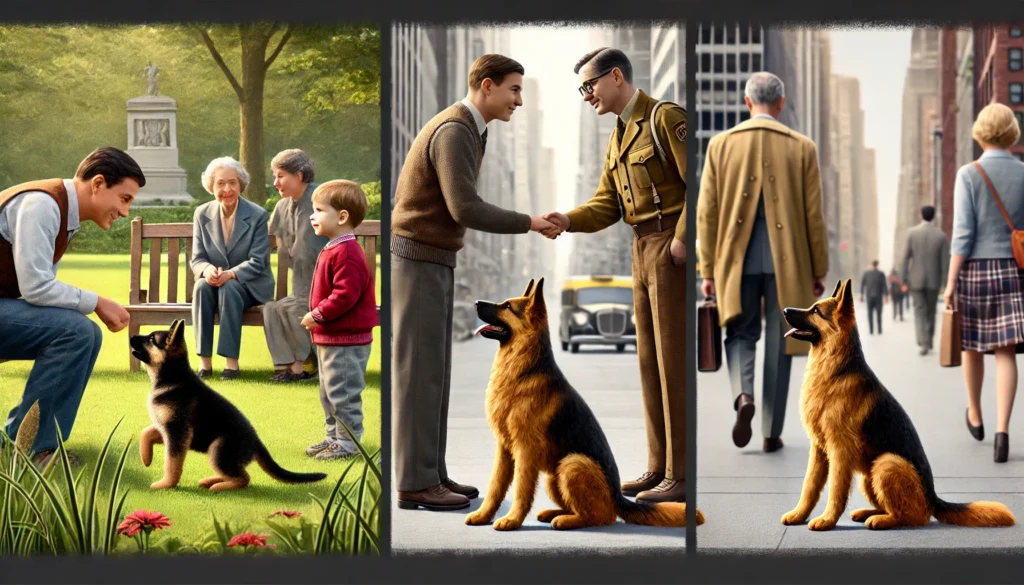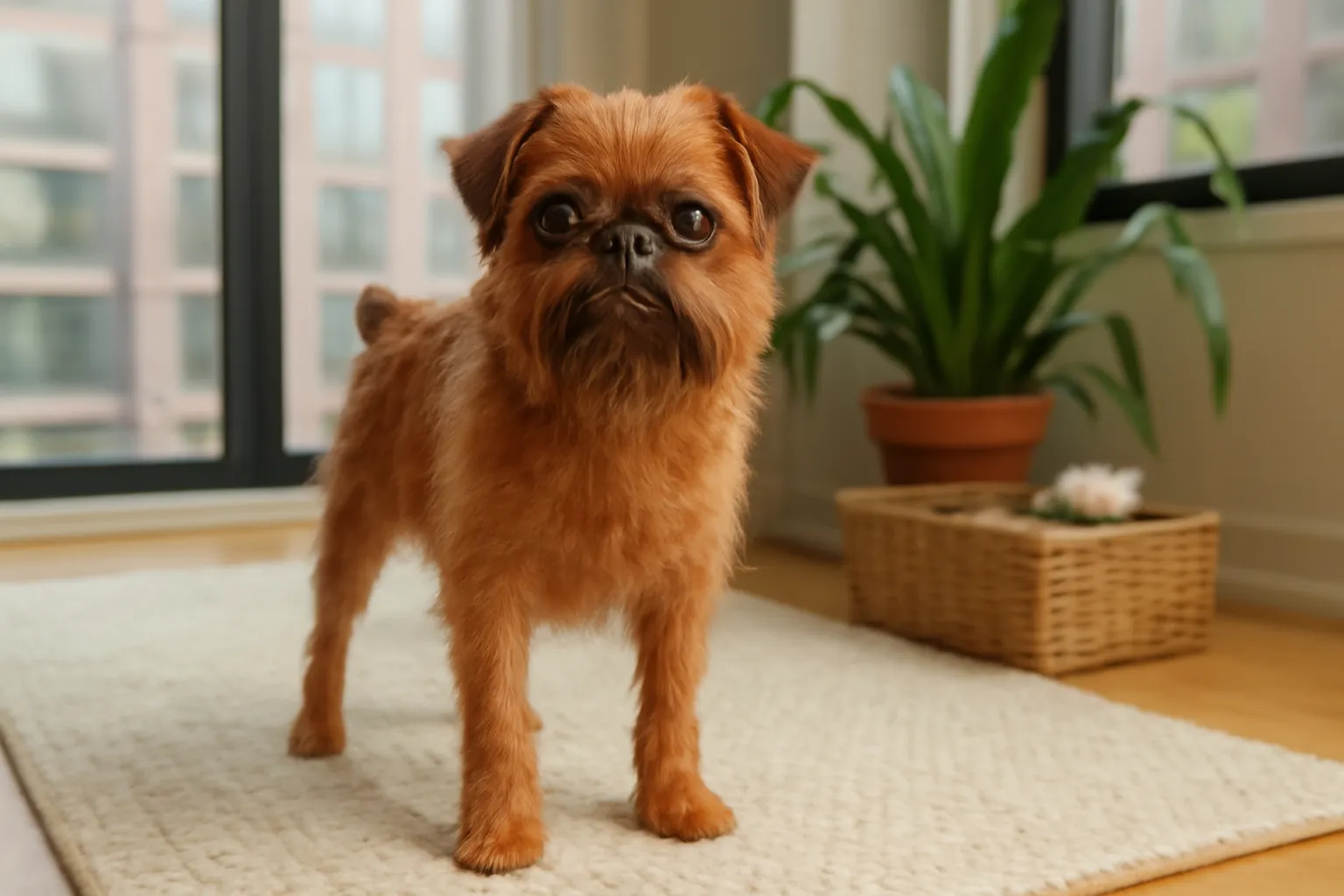Breed Berger Allemand: How to Socialize in 3 Easy Steps

Table of Contents
Introduction
Are you struggling with your Berger Allemand’s social skills? Many German Shepherd owners find themselves frustrated when their loyal companion shows signs of anxiety, fear, or even aggression around other dogs or people. This isn’t just embarrassing—it can be dangerous and significantly limit the adventures you can enjoy together.
Take heart! With the right approach, your Berger Allemand can transform from a nervous or reactive dog into a confident, well-adjusted companion. As a certified dog trainer with over a decade of experience specializing in working breeds, I’ve helped hundreds of Berger Allemand owners achieve remarkable transformations in their dogs’ social behavior, often in just a few weeks of consistent practice.
In this comprehensive guide, we’ll explore the most effective techniques for socializing your Berger Allemand based on their unique temperament and instincts. You’ll discover the three crucial steps that form the foundation of successful socialization, along with breed-specific strategies that address the particular needs of the Berger Allemand. We’ll cover everything from puppy socialization to rehabilitating adult dogs with established fear responses, plus detailed health considerations, training equipment recommendations, and answers to the most common questions about this magnificent breed.
Why This Dog Care Approach Works
The Berger Allemand, also known as the German Shepherd, requires socialization methods that honor their intelligence, protective instincts, and sensitivity. Generic approaches often fail because they don’t account for breed-specific traits. Our targeted socialization method works because:
- It respects the Berger Allemand’s natural development timeline, introducing new experiences at appropriate ages
- Uses positive reinforcement techniques scientifically proven to strengthen desirable behaviors while building confidence
- Focuses on quality of exposures rather than quantity, preventing overwhelming your sensitive Berger Allemand
- Incorporates progressive desensitization techniques particularly effective for this protective breed
- Recognizes and works with the breed’s natural guarding instincts rather than against them
- Dramatically improves your dog’s social confidence in as little as 2-3 weeks of consistent practice
- Adapts to different ages, from early puppy socialization to rehabilitating adult Berger Allemands
- Always keeps your dog under threshold, preventing traumatic experiences that could worsen reactivity
Understanding Your Dog’s Needs
Breed Profiles : The Berger Allemand
The Berger Allemand is a remarkable breed with complex needs that extend far beyond physical exercise. Originally developed in Germany in the late 19th century by Captain Max von Stephanitz, these dogs were bred specifically to be versatile working dogs with exceptional intelligence, loyalty, and trainability.
Understanding your Berger Allemand’s psychological makeup is essential for effective socialization. These dogs possess:
- Strong protective instincts toward their family
- Natural suspicion of strangers (a desired trait in working lines)
- High intelligence requiring regular mental stimulation
- Sensitivity to environmental changes and tensions
- A tendency toward strong bonds with primary caregivers
- Remarkable environmental awareness and alertness
The Berger Allemand’s natural vigilance can easily transform into reactivity without proper socialization. Their intelligence means they quickly form associations—both positive and negative—making early, positive exposure to various stimuli critical for their development.
Best Socialization Approach for Berger Allemand
When socializing a Berger Allemand, several breed-specific considerations must guide your approach:
- Early intervention is crucial—the critical socialization period for puppies ends around 14-16 weeks
- Controlled first impressions matter tremendously for this sensitive breed
- Building positive associations with novel stimuli requires patience and consistency
- Understanding the difference between normal protective behavior and problematic reactivity
- Recognizing that Berger Allemands may never be overtly friendly with strangers—and that’s okay
Unlike more naturally gregarious breeds, the well-socialized Berger Allemand typically displays neutral tolerance rather than exuberant friendliness toward strangers. Success means your dog can remain calm and non-reactive in various environments, not necessarily that they seek interaction with everyone they meet.
Behavior Management: Understanding Reactivity vs. Protection
Many Berger Allemand owners struggle to distinguish between their dog’s natural protective instincts and problematic reactivity. This distinction is crucial for effective training:
Natural Protective Behavior:
- Alert but calm assessment of new situations
- Appropriate warning signals (stiffening, focused attention) when genuine threats appear
- Ability to relax when you signal that a situation is safe
- Quick recovery after momentary alertness
Problematic Reactivity:
- Excessive barking, lunging, or growling at non-threatening stimuli
- Inability to calm down in new environments
- Stress signals like panting, pacing, whining in social situations
- Escalating rather than diminishing response to repeated exposures
The goal of proper socialization isn’t to eliminate your Berger Allemand’s protective nature—it’s to ensure these instincts remain under control and appropriate to actual threat levels.
Preparation & Requirements
Essential Supplies for Socializing Your Berger Allemand
Effective socialization of your Berger Allemand requires specific equipment designed to maximize safety and learning:
- Properly Fitted Equipment:
- Front-clip harness for better control without neck pressure
- 6-foot leash (avoid retractable leashes which provide inadequate control)
- Well-fitted martingale collar as backup to harness
- Optional head halter for dogs with established reactivity issues
- High-Value Reinforcers:
- Extra-special treats reserved only for socialization sessions
- Portable treat pouch for immediate reinforcement
- Favorite toy if your Berger Allemand is play-motivated
- Calming Aids:
- Thundershirt or anxiety wrap for noise-sensitive dogs
- Pheromone spray for environmental comfort
- Portable mat or place bed for establishing safe zones in public
- Safety & Management Tools:
- Muzzle (basket-style allowing treats, panting, and drinking) for dogs with bite history
- “In Training” or “GIVE ME SPACE” vest to signal to others
- Car barriers or crates for safe transport
Investing in quality equipment designed specifically for large, powerful breeds like the Berger Allemand is essential. Poor quality equipment can break under stress, potentially creating dangerous situations during critical socialization moments.
Health Basics: Pre-Socialization Health Checks
Before beginning intensive socialization with your Berger Allemand, ensure they’re physically prepared:
- Veterinary Clearance:
- Complete wellness examination
- Age-appropriate vaccinations (especially important for puppies)
- Parasite control updated
- Joint health assessment (Berger Allemands are prone to hip and elbow issues)
- Pain Assessment:
- Rule out hidden pain which can manifest as reactivity
- Check for sensitive areas that might be aggravated by equipment
- Consider thyroid testing for adult dogs with sudden behavior changes
As PRIME DOG TRAINING notes, “Any health concern or condition should be addressed by appropriate pet health care professional” before beginning training programs. Pain or discomfort can significantly impact your Berger Allemand’s tolerance for social situations.
Training Tools: Creating the Right Environment
Beyond physical equipment, successful socialization requires preparation of appropriate training environments:
- Safe Practice Spaces:
- Quiet, neutral areas for initial exposures
- Gradually more challenging environments as skills improve
- Identification of “emergency exits” in any training location
- Helper Network:
- Reliable friends with calm dogs for controlled interactions
- Professional trainer contacts for guided sessions
- Understanding family members who follow consistent protocols
- Environmental Management Tools:
- Visual barriers for reactive dogs (cars, trees, playground equipment)
- Distance control in public spaces
- Quiet times at parks when fewer triggers are present
Step-by-Step Dog Training Process
Step 1: Pre-Socialization Assessment and Preparation
Before beginning active socialization with your Berger Allemand, conducting a thorough assessment establishes your starting point and informs your approach:
- Temperament Evaluation:
- Document reactions to various stimuli (people, dogs, noises, etc.)
- Identify specific triggers that cause stress
- Determine threshold distances for different triggers
- Note calming signals and stress indicators specific to your dog
- History Compilation:
- For puppies: information about early experiences and breeder socialization
- For adult dogs: known past traumas or negative associations
- Previous training approaches that helped or hindered
- Family members’ observations of problematic situations
- Goal Setting:
- Define realistic expectations based on age and history
- Establish measurable progress indicators
- Create timeline for gradual exposure increases
- Determine success criteria appropriate for your specific Berger Allemand
- Environment Preparation:
- Secure a distraction-free home base for initial training
- Scout low-stimulus practice locations
- Arrange controlled helper scenarios for first exposures
- Create management plans for unavoidable challenging situations
The Berger Allemand’s intelligence means they quickly form associations with environments. Start with success-oriented scenarios where your dog can build confidence before facing more challenging situations.
Step 2: Controlled First Impressions for Your Berger Allemand
The first phase of active socialization focuses on creating positive associations with new stimuli at a distance where your Berger Allemand remains calm:
- Distance Introduction to Triggers:
- Begin far enough away that your dog notices the trigger but shows minimal reaction
- Pair the sight of triggers with high-value treats or play
- Practice “Look at That” games where noticing a trigger predicts rewards
- Gradually decrease distance as tolerance improves
- Desensitization to Environmental Factors:
- Separate challenging elements (sounds, movements, visual stimuli)
- Introduce each element individually before combining
- Use recordings or controlled exposures to practice
- Maintain relaxed body language and positive associations
- Counterconditioning With Precision:
- Treats ONLY appear when trigger appears (and disappear when trigger leaves)
- Work under threshold where your Berger Allemand can still take treats
- Focus on changing emotional response, not obedience
- End sessions while dog is still succeeding
- Recovery Practice:
- Intentionally move away from triggers after brief exposures
- Teach self-calming in semi-challenging situations
- Incorporate pattern games that refocus attention
- Recognize and reward natural disengagement
This phase typically requires 1-2 weeks of consistent practice with your Berger Allemand, depending on their starting point and your consistency.
Step 3: Progressive Socialization for Your Berger Allemand
Once your dog demonstrates relaxed behavior at a distance, you can begin more active socialization:
- Controlled Parallel Activities:
- Walk parallel to other dogs with gradually decreasing distance
- Practice neutral passing scenarios with humans at increasing proximity
- Participate in group classes where all dogs maintain appropriate distance
- Reward calm behavior in busy environments without direct interaction
- Structured Interactions:
- Arrange meetings with stable, socially appropriate dogs
- Begin with brief, positive interactions (3-5 seconds)
- Allow proper greeting etiquette (side approaches, curved pathways)
- End interactions while both dogs are still comfortable
- Generalization Across Environments:
- Practice in different locations, times of day, and weather conditions
- Gradually increase environmental challenges (busier parks, louder areas)
- Maintain success ratio (80% successful experiences for every challenge)
- Track progress across different contexts
- Proofing Under Distraction:
- Add movement, excitement, and unpredictability gradually
- Practice emergency recall away from interesting situations
- Simulate challenging scenarios in controlled settings
- Test and reinforce boundaries with helpers
This phase typically spans 4-8 weeks for most Berger Allemands, though progress continues throughout their lifetime. The goal isn’t to rush through steps but to build genuine confidence through repeated positive experiences.
Pro Tips for Dog Care Success
Avoiding Common Mistakes When Socializing Berger Allemand
Even well-intentioned owners often make these mistakes when socializing their Berger Allemand:
- Forced Interactions:
- NEVER force your reluctant Berger Allemand to interact with people or dogs
- Avoid dog parks for socialization (too uncontrolled for this sensitive breed)
- Don’t allow strangers to reach for your dog’s head or crowd them
- Respect your dog’s communication when they show discomfort
- Reinforcing Reactivity:
- Don’t tighten the leash in anticipation of problems (creates tension)
- Avoid reassuring worried behaviors (can reinforce anxiety)
- Never punish growling (suppresses important warning signals)
- Don’t rush exposure processes out of embarrassment or impatience
- Inconsistent Handling:
- Mixed signals about whether situations are safe or dangerous
- Inconsistent reactions to your dog’s behavior
- Allowing some people to interact differently than others
- Changing equipment or methods too frequently
- Misinterpreting Breed Traits:
- Expecting your Berger Allemand to enjoy meeting all strangers
- Misreading alertness as aggression
- Assuming all reactive behavior is protection rather than fear
- Comparing your dog to more naturally social breeds
Product Recommendations for Berger Allemand Training
Quality equipment makes a significant difference when socializing a powerful, intelligent breed like the Berger Allemand:
- Training Harnesses:
- Blue-9 Balance Harness (highly adjustable for the Berger Allemand’s deep chest)
- Freedom No-Pull Harness (front and back attachment points)
- Ruffwear Front Range (durable for active training sessions)
- Training Treats:
- Small, soft, high-value treats that can be consumed quickly
- Freeze-dried liver or lung (high value without stomach upset)
- Squeeze cheese or meat tubes for extreme value in challenging situations
- Variety packs to prevent preference fatigue
- Calming Aids:
- Adaptil collar or diffuser (uses dog-appeasing pheromones)
- ThunderShirt (provides gentle pressure for anxiety reduction)
- Licking mats (promote calming through repetitive licking)
- Training Resources:
- Engage All Dogs (online course specifically for reactive dogs)
- Control Unleashed by Leslie McDevitt (pattern games for reactivity)
- BAT 2.0 by Grisha Stewart (empowerment approach for fearful dogs)
As mentioned on tibetandogchew.com, positive reinforcement techniques using high-quality treats can significantly improve training outcomes when teaching essential commands like “come,” which are crucial for safety during socialization efforts.
Health Monitoring During Socialization
The socialization process can be stressful for your Berger Allemand. Monitor these health indicators throughout the process:
- Stress Indicators:
- Changes in appetite or elimination habits
- Increased shedding or dandruff
- Sleep disturbances or lethargy after sessions
- Increased water consumption
- Physical Comfort:
- Check equipment fit regularly (growth changes needs)
- Examine paws for wear from increased training
- Monitor weight and muscle tone as activity increases
- Watch for joint discomfort after more active sessions
- Mental Well-being:
- Track recovery time after challenging exposures
- Note changes in home behavior after training
- Watch for displacement behaviors increasing or decreasing
- Observe changes in confidence in familiar environments
If you notice concerning health changes, consult with a veterinarian. According to dogqualitycare.com, “Guarantee your canine is solid. Medical problems can influence a canine’s way of behaving and capacity to learn.”
Care Variations
Puppy Socialization: Special Considerations for Young Berger Allemand
Socializing a Berger Allemand puppy requires specific approaches that respect their developmental timeline:
- Critical Period Focus (8-16 weeks):
- Prioritize positive exposures to diverse stimuli during this window
- Create a “puppy socialization checklist” covering various categories
- Balance exposure with appropriate vaccination protection
- Track reactions to identify early sensitivity patterns
- Age-Appropriate Exposures:
- 8-10 weeks: Focus on environmental stimuli, gentle handling
- 10-12 weeks: Introduce controlled dog interactions with stable adults
- 12-14 weeks: Begin brief public exposures with careful management
- 14-16 weeks: Proactive work on potential fear periods
- Puppy Class Selection:
- Choose classes with enforced rest periods (prevents overstimulation)
- Look for small ratios of puppies to instructors
- Ensure separate play areas for different sizes
- Confirm trainers who understand German Shepherd development
- Prevention Focus:
- Identify early signs of resource guarding and address immediately
- Watch for emerging sensitivity to handling specific body areas
- Note any sound sensitivities developing (common in Berger Allemand)
- Track early reaction to strangers for potential protective tendencies
Young Berger Allemand puppies should meet at least 100 new people in their first few months, with careful attention to making these experiences positive rather than overwhelming.
Adult Berger Allemand Socialization: Rehabilitation Approaches
Socializing an adult Berger Allemand with established reactivity requires more intensive intervention:
- Baseline Establishment:
- Implement complete management to prevent rehearsal of reactive behaviors
- Create detailed trigger logs identifying specific stimuli and contexts
- Establish safe zones where the dog can fully relax
- Determine whether fear, frustration, or protection motivation drives reactions
- Trust Building:
- Focus first on handler-dog relationship and communication
- Establish clear patterns of safety and predictability
- Develop strong foundation behaviors for emergency situations
- Build duration of calmness in progressively challenging environments
- Systematic Desensitization:
- Create controlled setups with precise distance calculations
- Use barriers strategically for early work
- Incorporate pattern games that promote cognitive function
- Establish clear start and end signals for training sessions
- Professional Support:
- Consider consultation with veterinary behaviorist for severe cases
- Work with trainers experienced specifically with Berger Allemand
- Evaluate whether medication might be appropriate temporary support
- Join support groups for owners of reactive dogs for emotional support
Adult rehabilitation typically takes significantly longer than puppy socialization—expect 3-6 months of consistent work for noticeable changes, with continued management for life in many cases.
Breed-Specific Considerations for the Berger Allemand
The Berger Allemand’s unique characteristics require tailored approaches to socialization:
- Working vs. Show Lines:
- Working lines typically show higher environmental sensitivity and drive
- Show lines may display less intensity but still require thorough socialization
- Adjust expectations and approaches based on your dog’s genetic background
- Work within your individual dog’s temperament rather than against it
- Exercise Requirements:
- Ensure physical needs are met before socialization sessions
- Incorporate mental stimulation to prevent frustration behaviors
- Balance training with appropriate outlet for natural drives
- Recognize correlation between overall exercise and reactivity thresholds
- Maturity Timeline:
- Understand that Berger Allemand mature slowly (2-3 years for full maturity)
- Expect developmental fear periods around 8-10 months
- Anticipate increased territorial behavior during adolescence
- Recognize that some social behaviors won’t stabilize until full maturity
- Handler Relationship:
- Honor the breed’s handler focus as an advantage in training
- Build stronger engagement before working around major distractions
- Utilize the breed’s natural desire to work cooperatively
- Maintain clear leadership while avoiding compulsion-based methods
Health Enhancement for Your Berger Allemand

Nutrition Strategies Supporting Behavioral Health
The connection between diet and behavior is particularly relevant for the sensitive Berger Allemand:
- Balanced Nutrition Basics:
- High-quality protein sources appropriate for large breeds
- Appropriate fat content for brain health and coat condition
- Limited fillers that may cause blood sugar fluctuations
- Consistent feeding schedule to prevent hunger-related stress
- Supplements for Behavioral Support:
- Omega-3 fatty acids for cognitive function and inflammation reduction
- L-theanine for stress reduction in anxiety-prone individuals
- Probiotics for gut-brain axis support
- Vitamin B complex for nervous system function
- Special Dietary Considerations:
- Food sensitivity testing if behavioral issues coincide with digestive symptoms
- Limited ingredient diets for dogs with suspected food allergies
- Appropriate calorie adjustments based on activity level
- Fresh food additions for better nutrient absorption
- Hydration and Feeding Practices:
- Constant access to fresh water, especially during training
- Slow feeder bowls to prevent bloat (common in Berger Allemand)
- Consider puzzle feeders for mental stimulation
- Separate feeding from high-arousal activities
According to research, deficiencies in certain nutrients can contribute to increased reactivity and decreased stress resilience—particularly relevant for sensitive breeds like the Berger Allemand.
Exercise Routines: Physical and Mental Stimulation
The Berger Allemand requires a balanced approach to exercise that addresses both physical and mental needs:
- Physical Exercise Framework:
- 60-90 minutes daily of combined activities
- Mixture of aerobic exercise and strength building
- Joint-friendly options (swimming, controlled trotting)
- Appropriate exercise progression based on age and fitness
- Mental Stimulation Requirements:
- Scent work (particularly fulfilling for Berger Allemand)
- Problem-solving games and puzzle toys
- Training in new skills and behaviors
- Environmental exploration with appropriate safety
- Structured Activity Options:
- Tracking (taps into natural abilities)
- Agility at appropriate levels for physical development
- Rally obedience for focus building
- Treibball as a herding outlet without livestock
- Decompression Activities:
- Sniff walks on long lines
- Digging in designated areas
- Chewing appropriate long-lasting items
- Quiet observation periods in new environments
Proper exercise significantly impacts your Berger Allemand’s threshold for reactivity. An under-exercised dog will show dramatically lower tolerance for social stressors compared to one whose physical and mental needs are consistently met.
FAQs
How do I socialize my Berger Allemand if they’re already reactive?
Socializing an already-reactive Berger Allemand requires a more careful, structured approach:
- First, implement complete management to prevent rehearsal of reactive behaviors while you build new skills.
- Work with a professional trainer experienced with reactive German Shepherds to create a customized plan.
- Begin with desensitization at distances where your dog remains under threshold.
- Use counter-conditioning to change the emotional response to triggers.
- Progress extremely gradually, measuring success by your dog’s emotional state rather than proximity to triggers.
- Consider muzzle training for safety and increased freedom during the rehabilitation process.
- Recognize that management will likely remain a component of your strategy even after significant improvement.
The rehabilitation process for an adult reactive Berger Allemand typically takes 3-6 months of consistent work to see substantial improvement.
At what age should I start socializing my Berger Allemand puppy?
Socialization should begin immediately when you bring your Berger Allemand puppy home, typically around 8 weeks of age:
- The critical socialization period extends from approximately 3 to 14 weeks of age.
- During this period, puppies form lasting impressions about what is safe or dangerous in their environment.
- Balance socialization needs with vaccination protection by using controlled environments.
- Carry young puppies in public areas where unvaccinated dogs may have been.
- Invite screened visitors to your home to meet your puppy.
- Use puppy-specific classes that require appropriate vaccinations for the age.
- Focus on quality, positive exposures rather than quantity or overwhelming situations.
Early, positive socialization is particularly crucial for the Berger Allemand due to their natural protective tendencies.
Will my Berger Allemand ever enjoy meeting strange dogs and people?
The Berger Allemand breed standard actually calls for a degree of aloofness toward strangers, which is important to understand when setting expectations:
- The goal of socialization for this breed is typically neutral tolerance rather than enthusiasm.
- A well-socialized Berger Allemand may never actively seek interaction with strangers or unknown dogs.
- Success means your dog can remain calm and non-reactive around new people and dogs.
- Some individual Berger Allemands may be more naturally social, but this varies by bloodline and individual temperament.
- Respect your dog’s natural personality rather than forcing interactions.
- Focus on building confidence and neutral experiences rather than expecting extroverted behavior.
- Value your dog’s discernment and good judgment about genuinely concerning situations.
How do I handle strangers who want to pet my Berger Allemand?
Managing public interactions with your Berger Allemand requires clear communication and boundaries:
- Use equipment that signals your training status, such as a vest stating “IN TRAINING” or “GIVE ME SPACE.”
- Practice a default “meeting routine” where you ask the dog to sit slightly behind you.
- Develop a standard, polite response to requests: “He’s in training right now, but thank you for asking!”
- For friendly dogs, teach them to only greet when given an explicit permission cue.
- Position yourself between your dog and approaching strangers.
- Be willing to advocate firmly for your dog’s space needs.
- For children, use it as an educational opportunity about proper dog greeting etiquette.
Remember that allowing forced interactions can damage your socialization progress. As a Berger Allemand owner, protecting your dog from overwhelming situations is your responsibility.
How can I tell if my Berger Allemand is stressed during socialization?
Recognizing stress signals in your Berger Allemand is essential for effective socialization:
- Early Stress Indicators:
- Lip licking when no food is present
- Yawning out of context
- Whale eye (showing whites of eyes)
- Ears positioned back or to the side
- Shifting weight backward
- Increased vigilance or scanning
- Moderate Stress Signals:
- Stiff body posture
- Raised hackles
- Hard staring
- Inability to respond to familiar cues
- Panting when not hot or exercised
- Refusal of treats they normally enjoy
- High Stress Signals:
- Growling, barking, lunging
- Trembling or freezing
- Attempting to flee
- Excessive drooling
- Dilated pupils
Learn your individual dog’s specific stress signals, as they can vary between dogs. When you notice early stress signals, increase distance from the trigger or end the session before escalation occurs.
Should I use a muzzle when socializing my Berger Allemand?
Muzzle training can be a valuable tool for socializing a Berger Allemand, regardless of bite history:
- A properly fitted basket muzzle allows normal breathing, panting, drinking, and treating.
- Muzzles prevent rehearsal of unwanted behaviors during the learning process.
- They provide peace of mind that allows you to remain calmer, which helps your dog.
- Muzzles create a visual signal to others to maintain appropriate distance.
- They allow for controlled socialization in more environments than would otherwise be safe.
- Proper muzzle conditioning involves building positive associations gradually.
- Begin muzzle training well before you need it in challenging situations.
The goal is for your dog to view the muzzle as a positive indicator of fun activities, never as punishment or something to be feared.
Conclusion
Socializing your Berger Allemand is one of the most important investments you can make in your dog’s long-term wellbeing and your relationship together. While this magnificent breed does present some unique challenges in the socialization process, their intelligence and loyalty make them incredibly rewarding partners when properly trained.
Remember that successful socialization for a Berger Allemand doesn’t mean creating an indiscriminately friendly dog—it means developing a confident, discerning companion who can navigate various environments with calm self-assurance. Your dog’s natural protective instincts are valuable traits when properly channeled through thoughtful socialization.
Begin implementing these socialization techniques today, and you’ll be amazed at how quickly your Berger Allemand can progress. The three-step approach—assessment, controlled first impressions, and progressive socialization—provides a clear roadmap even for dogs with established reactivity.
You’re not alone in this journey. Join the community of successful Berger Allemand owners who have transformed their dogs’ social behavior through these methods. Whether you’re starting with a puppy or rehabilitating an adult dog, the principles remain the same: patience, consistency, and respect for your dog’s unique personality and breed traits.
For more breed-specific guidance, check out our comprehensive guide to Berger Allemand healthcare essentials and advanced training techniques for working breeds.
Your Berger Allemand has the potential to be an exceptional companion in any environment—start building that foundation today!








